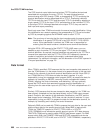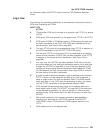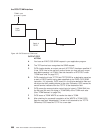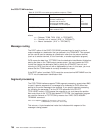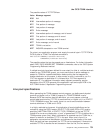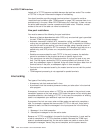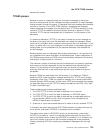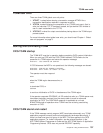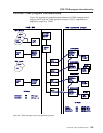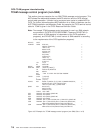
To allow processing of input to continue, DFHTEP may take either of the following
steps:
v If the input line is placed in service by DFHTEP, the CICS-TCAM interface retries
the operation. In this case, a count mechanism is recommended in DFHTEP to
prevent a loop occurring if the task never issues a READ, or a TCTTE never
becomes available.
v Perhaps when a count limit is reached, DFHTEP might abend the task, dispose
of the data, and place the line in service.
For further information about DFHTEP, see “Terminal error program” on page 416.
The problem of unsolicited input caused by condition 4 can be eliminated entirely by
having a separate TCAM input process queue for each CICS terminal (TCTTE).
However, as the number of terminals increases, this solution may quickly use up
too much main storage.
You should analyze the type of traffic that you anticipate over the queues. If a 2770
Data Communication System, or a 2780 Data Transmission Terminal, is to read in
volumes of cards, you should consider having separate queues for these devices.
However, devices can share queues if traffic is conversational with short-lived tasks.
The same TCAM output process queue can be specified for multiple input process
queues. (See the discussion of the DFHTCT TYPE=LINE,OUTQ=symbolic name
specification in the
CICS Resource Definition Guide
.)
You need not be concerned with locking the TCAM output process queue, because
TCAM requeues the data according to its final destination once it arrives over the
output queue.
It is possible for the TCAM output process queue to become congested because of
lack of queuing space. In this case, CICS has a WRITE to the queue outstanding
until TCAM accepts the data.
If the length of a message passed to a TCAM queue exceeds the queue’s block
size (specified in the DCB), DFHTCAM causes DFHTACP to be attached with
‘output area exceeded’ (error code X'8F').
TCAM devices
In a non-TCAM environment, the CICS terminal control program is responsible for
polling and addressing terminals, code translation, transaction initiation, task and
line synchronization, and the line control necessary to read from or write to a
terminal. When TCAM is specified, terminal control relinquishes responsibility to the
TCAM MCP for polling and addressing terminals, code translation, and line control.
To take advantage of TCAM facilities, code, in the MCP message handler, functions,
such as code translation, that were previously handled by the CICS terminal control
program.
For some terminal services, it is necessary for CICS to pass the user request on to
the TCAM MCP message handler. A communication control byte (2 bytes in TCAM
SNA) in the TCAM work area has been established for this purpose. It is passed to
TCAM along with the 8-byte destination name field. You must execute the
appropriate MCP message-handler macros according to the contents of the
communication byte.
the CICS-TCAM interface
704
CICS TS for OS/390: CICS Customization Guide



